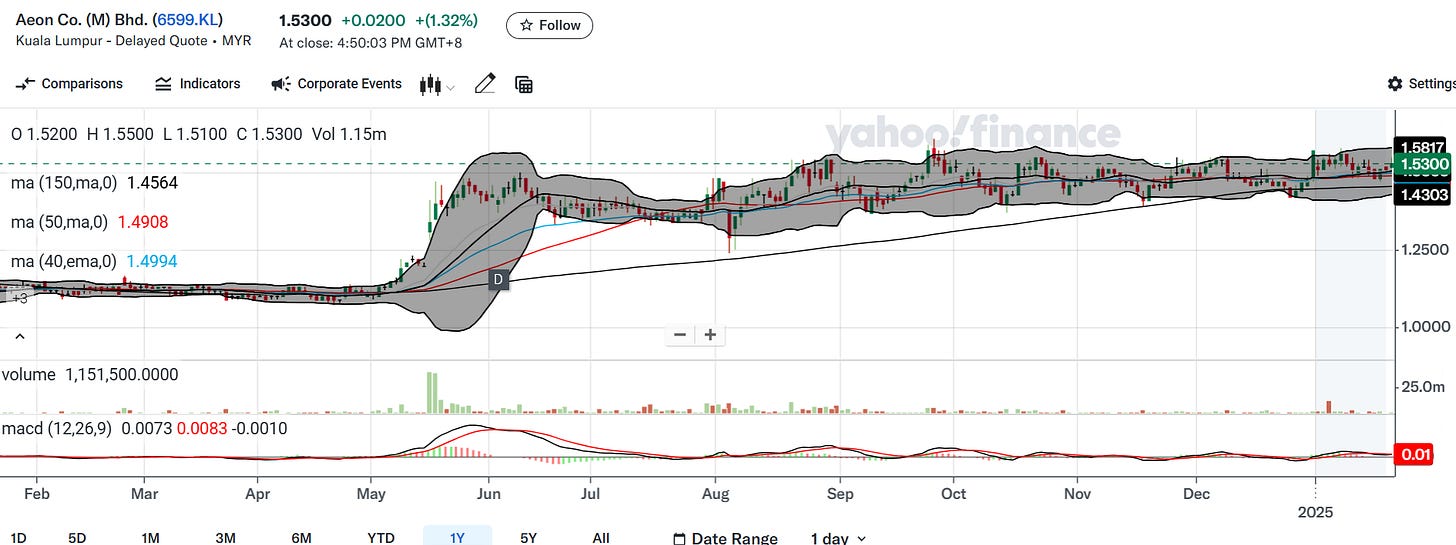Three Mistakes to Avoid When Investing in Malaysian Stocks - KingKKK
KingKKK
Publish date: Sat, 19 Oct 2024, 07:50 PM
Introduction
Investing in Malaysian stocks can be a rewarding experience, thanks to the country's diverse economy, strategic location in Southeast Asia, and a wide range of industries. From blue-chip stocks like those listed on the FTSE Bursa Malaysia KLCI (FBMKLCI) to smaller companies with high growth potential, Malaysia offers many opportunities for investors to grow their wealth. However, as with any market, pitfalls abound. To be successful, investors must steer clear of common mistakes that can severely impact their returns.
This article will cover three major mistakes that investors should avoid when investing in Malaysian stocks: chasing speculative plays, overlooking fundamental research, and poor diversification.
1. Chasing Speculative Plays
The first common mistake investors often make in Malaysia is chasing speculative stocks. These are stocks that see rapid price movements, often driven by rumors, hype, or short-term catalysts rather than solid fundamentals. Malaysian retail investors, like many others globally, can sometimes get swept up in the frenzy, buying stocks with no real business prospects simply because of price momentum.
Why Speculation Can Be Dangerous
Speculative plays can deliver quick profits, but they are also incredibly risky. When a stock rises dramatically in price without a corresponding increase in earnings or revenue, the bubble is bound to burst at some point. Speculative stocks are prone to extreme volatility, and while a few lucky investors might ride the wave to a profit, many others will likely get caught when the stock crashes back to its intrinsic value.
How to Avoid This Mistake
Avoiding speculative plays requires discipline. Before purchasing any stock, ask yourself whether the company has sound fundamentals: is it profitable, does it have a sustainable business model, and does it have a competitive advantage? If the answer to these questions is no, it may be best to avoid the stock, even if it is gaining momentum in the short term. Focus on long-term, value-based investing rather than short-term speculation.
2. Overlooking Fundamental Research
Another significant mistake that investors in Malaysia make is neglecting fundamental research. Many investors rely too much on "hot tips" from friends, social media, or online forums without fully understanding the companies they are investing in. While these tips can sometimes lead to short-term profits, they are often unreliable in the long run.
The Importance of Fundamental Analysis
Fundamental analysis involves evaluating a company’s financial statements, management quality, industry conditions, and economic factors to determine its intrinsic value. In Malaysia, where corporate governance standards can sometimes be inconsistent, conducting thorough research is especially important. By understanding a company’s fundamentals, you can assess whether a stock is overvalued, undervalued, or fairly priced.
Key Metrics to Watch
When analyzing Malaysian companies, some key financial metrics to consider include:
Price-to-Earnings (P/E) Ratio: This ratio compares a company's current share price to its per-share earnings. A lower P/E ratio might indicate that a stock is undervalued.
Price-to-Book (P/B) Ratio: This ratio compares the market price to the company's book value. A lower P/B ratio could signal that a stock is trading below its actual worth.
Dividend Yield: Many Malaysian companies, particularly large, well-established ones, pay regular dividends. A high dividend yield can be attractive for income-seeking investors, but it’s essential to ensure the dividends are sustainable.
Return on Equity (ROE): This metric tells you how well a company uses shareholders' equity to generate profits. A higher ROE indicates a more efficient company.
By focusing on these metrics and understanding the underlying business of the companies you invest in, you’ll be better positioned to make informed decisions and avoid potential pitfalls.
Case Study: Financial Institutions in Malaysia
Banks in Malaysia, such as Maybank and Public Bank, are often considered "safe" investments due to their stable dividend payouts and strong balance sheets. However, it's still crucial to conduct research on the macroeconomic environment that affects the banking industry, such as interest rates and government policies. For instance, if Bank Negara Malaysia raises interest rates, banks might benefit from higher net interest margins, boosting profitability. Conversely, in times of economic downturns, banks may suffer from higher non-performing loans, leading to weaker performance.
How to Avoid This Mistake
To avoid overlooking fundamental research, take the time to review a company’s financial reports, annual statements, and analyst opinions. Resources such as Bursa Malaysia’s website, i3investor, and Bloomberg provide access to financial data and analyst reports that can help you make informed decisions. Additionally, consider using stock screeners to identify stocks that meet your investment criteria based on metrics such as valuation, dividend yield, and earnings growth.
3. Poor Diversification
The third critical mistake investors make when investing in Malaysian stocks is poor diversification. Some investors put too much of their portfolio into a single sector or stock, leaving them highly exposed to industry-specific risks. Others may concentrate too much of their portfolio on Malaysian stocks and miss out on the growth potential offered by global markets.
Sector-Specific Risks
Malaysia’s stock market has certain sectors that dominate, such as financial services, palm oil, and telecommunications. Overconcentration in any one of these sectors can be dangerous, especially if the sector experiences a downturn. For example, the palm oil sector is highly sensitive to global commodity prices and government policies, both in Malaysia and in export markets like India and China. If the demand for palm oil declines, investors who are overly concentrated in plantation stocks may see their portfolios suffer significant losses.
The Role of Global Diversification
Malaysia’s economy, while relatively stable, is still a developing market and can be affected by factors such as political uncertainty, currency volatility, and slower economic growth. By diversifying internationally, investors can reduce their exposure to domestic risks. For instance, investing in developed markets like the U.S. or Europe or even other emerging markets in Asia can provide a buffer during times of local economic downturns.
Case Study: The Oil & Gas Sector
Malaysia’s oil and gas sector has long been a favorite of local investors. However, the sector is highly cyclical and vulnerable to swings in global oil prices. When oil prices are low, companies in this sector face declining revenues and profits, which can lead to steep losses for investors. Diversifying into non-energy sectors or even markets outside of Malaysia can help investors mitigate the risk of such downturns.
How to Avoid This Mistake
To avoid poor diversification, consider building a balanced portfolio that includes a mix of sectors, industries, and geographies. Within the Malaysian market, aim to diversify across different sectors like technology, healthcare, consumer goods, and real estate. Additionally, consider exposure to international markets through foreign stocks, exchange-traded funds (ETFs), or mutual funds that invest globally.
Conclusion
Investing in Malaysian stocks offers both opportunities and risks. By avoiding the common mistakes of chasing speculative plays, overlooking fundamental research, and poor diversification, investors can better position themselves for long-term success. The key is to remain disciplined, focus on the fundamentals, and ensure your portfolio is well-diversified. Doing so will not only protect you from downside risks but also enhance your potential for sustainable returns in Malaysia’s dynamic market.
My other posts:
Unveiling Market Gems: Your Guide to Beating the Market (substack.com)
MRCB: Bouncing Back - Can It Sustain The Recent Momentum? (substack.com)
Econpile: Double Bottom or Bullish Engulfing? (substack.com)
MALAKOF: Uptrend Continuation With Potential MACD Crossover? (substack.com)
MAGNI-Tech on the rise, is a Major Breakout Brewing? (substack.com)
IHH Healthcare: An Uptrend Defensive Stock (substack.com)
IGBREIT: An Uptrend REIT To Weather The Storm (substack.com)
FFB: Positioned for a New High? - KingKKK’s Substack
KLCC - A Deep Dive Into the Chart's Next Move (substack.com)
ABMB: Ready to Soar or Due for a Pullback? (substack.com)
PBBANK: Short-Term Pullback or Long-Term Gain? (substack.com)
KPJ: Breakout Stock with Crossover and Uptrend Pattern (substack.com)
US Fed Slashes Rate: Here's How It Will Reshape Malaysia Stock Market (substack.com)
YTLPOWER: Reversal Ahead? Hammer + MACD Crossover Pattern Emerging... (substack.com)
SIMEPROP: Momentum Building For A Surge? (substack.com)
APOLLO: Strong Fundamentals Amidst a Neutral Technical Setup - Is It A Time To Buy? (substack.com)
China's Moves and Their Ripple Effect on Malaysia’s Stocks (substack.com)
HPP Holdings: Ready for a Strong Rally? (substack.com)
DPHARMA: Reaping the Rewards of a Strong Ringgit (substack.com)
Crescendo: Bulls Take Charge? - KingKKK’s Substack
GAMUDA: Bonus Issue Unlocks New Technical Strength (substack.com)
FBMKLCI Shake-Up in Q3: Sector Winners and Losers (substack.com)
HLBANK: Analyzing the Bullish Signals on the Chart (substack.com)
AEON: Can This Rally Continue? - KingKKK’s Substack
SUNREIT: Poised for a Breakout? - KingKKK’s Substack
MYNEWS: Moderately Bullish - KingKKK’s Substack
Malaysia Airports: Bullish Momentum or Stalling? (substack.com)
Maybank's Next Move: A Bullish Setup in the Making? (substack.com)
SUNWAY's Uptrend: Consolidation or Continuation? (substack.com)
TENAGA: Poised to resume its uptrend? - KingKKK’s Substack
RHBBANK: Consolidation Phase or Breakout Ahead? (substack.com)
TOPGLOV: Consolidation or Breakout? - KingKKK’s Substack
BURSA: Poised for a New Rally or Stuck in Sideways Action? (substack.com)
PBBANK: Buy the Dip or Wait? - KingKKK’s Substack
MYEG: In Consolidation Phase - KingKKK’s Substack
SIMEPROP: Moving Averages Signal Strong Uptrend (substack.com)
SD Guthrie: Steady Climb or False Start? (substack.com)

More articles on Stock Market Enthusiast





Created by KingKKK | Jan 23, 2025

Created by KingKKK | Jan 22, 2025




Discussions
Make no mistake. Do not invest in Malaysia stocks.
Just invest into Singapore stocks.
Foreign dividends are tax free until 31 December 2026.
2024-10-20 12:41
A good read, only the third item “The third critical mistake investors make when investing in Malaysian stocks is poor diversification” is a ‘mistake’ I make and continue making..
For the last few years, I only bought some blue chip counter (10%), the rest was penny stocks hoping for a strong market recovery which ‘a high tide will raise all boats’..Happy Trading and TradeAtYourOwnRisk.
2024-10-20 14:40
Good article. I would like to further enhance the insights provided. It is advisable to acquaint yourself with fundamental accounting principles. This knowledge is essential for interpreting financial statements accurately. Developing this skill could prove to be invaluable in your lifetime.
2024-10-21 12:45
in bursa oly two names stand out as investments.......99 speedmart and natgate. 99 speedmark $ 2.50 already ....not the ime to buy compared to 1.80....natgate come down from a high of 2.50 due to placements of shares and ringgit. Natgate very impressive last quarter results......natgate looks investible.
other than that, for genuine investors HK shares looks good for 1-2 years period
2024-10-21 17:00



















KingKKK
Three Mistakes to Avoid When Investing in Malaysian Stocks - KingKKK
https://klse.i3investor.com/web/blog/detail/bestStocks/2024-10-19-story-h471952251-Three_Mistakes_to_Avoid_When_Investing_in_Malaysian_Stocks
2024-10-19 19:51